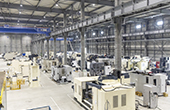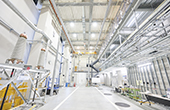Washimibashi Bridge is a road bridge on the expressway up in the mountains of Gifu Prefecture. The region attracts lots of skiers and snowboarders. But how many of them will notice this magnificent bridge? When you are crossing a bridge in your car, driving along an expressway, you can’t see the bridge because you are on it. In fact, you scarcely notice it. From your perspective, the bridge is just a continuation of the road.
I wish people visiting the region for the skiing could enjoy a panoramic view of this magnificent bridge. The simplicity of the bridge design perfectly complements the green of the forested mountains and the blue sky with its scattering of clouds. It’s ravishingly beautiful, aesthetically delightful. I can imagine another beautiful scene: the bridge soaring elegantly above a snowbound, wintry landscape.
But there is much more to Washimibashi Bridge than good looks. It also has a remarkable structure. The piers have been constructed using a method called SPER—short for Sumitomo Mitsui’s Precast Form for Earthquake Resistance and Rapid Construction. This involves prefabricating half-precast concrete components at a factory and then assembling them at the construction site. The setting of concrete is subject to variation depending on the weather and other environmental conditions. So fabricating concrete components at a factory under consistent conditions helps to achieve stable quality and use of prefabricated components speeds construction. The SPER method maximizes these advantages. Having received this explanation, I peered more intently at the piers and could get an idea of how the various sections were combined at the site. In my mind’s eye, I could visualize the assembly work.
Another interesting insight is that when building a pier head, segments are added one by one on either side to maintain balance. I didn’t imagine that the horizontal structure of the bridge, perched atop the vertical piers, is extended bit by bit as if two arms were stretching out toward each other across the void and eventually clasping hands when the final section is put in position. The structure also includes a space where technicians can walk around to do maintenance. So you can actually go inside a bridge.
Washimibashi Bridge is such a remarkable example of engineering excellence in a superb natural setting, but it is not well known. I would like to think more and more people visiting the region will take a side trip to view this beautiful bridge.
But on reflection, like other gigantic structures I have visited so far, the most attractive attribute of this bridge is its understated, steady, reassuring character. It’s just there. And in its inimitable, quiet way, it not only helps people get from one place to another, but also empowers them to fulfill their aspirations. Awe-inspiring! My affection for outsize structures is deepening.

 EN
EN



















































